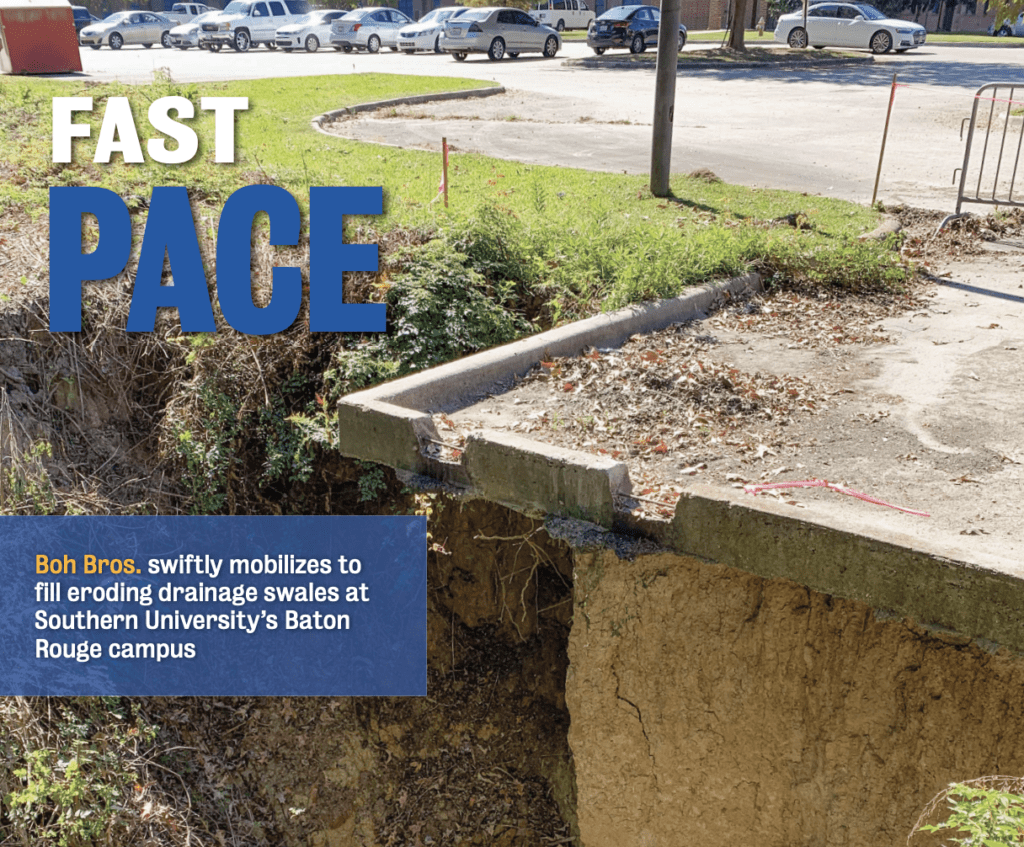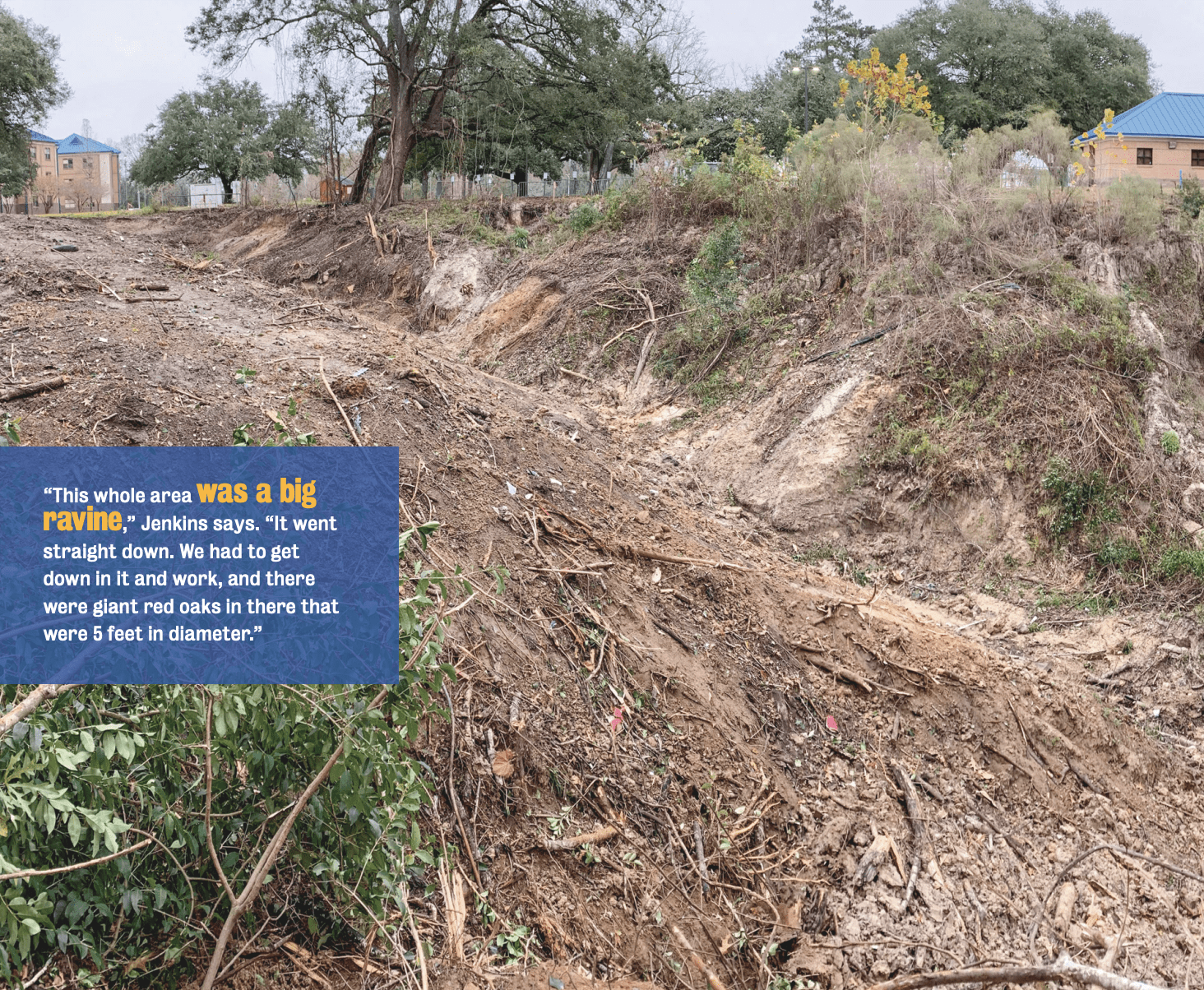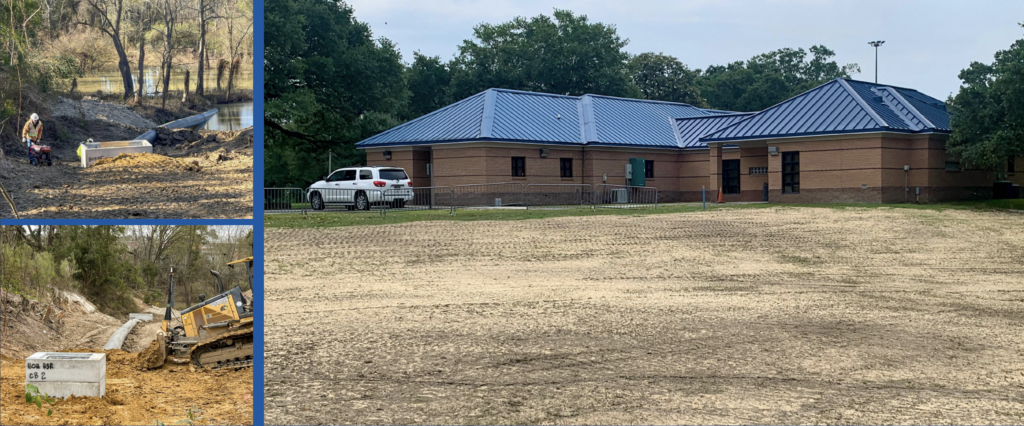
Several drainage swales were rapidly eroding at Southern University’s Baton Rouge campus this past fall and threatening a heavily used Student Health Center and residential parking lot. There were also alarming signs that one of the drainage swales was about to undermine an electrical transformer foundation.
Given the urgency, Huval & Associates turned to Boh Bros. Construction for help with a quick solution. The Lafayette-based engineer holds the emergency contract with the Louisiana Department of Transportation and Development, the overseer of the state-funded project. “The issue was brought to our attention in August 2021,” says Glenn McCall, Huval’s senior project engineer. “After observing the erosion and its proximity to the Health Center, it became obvious that we needed to do something quickly so that the building could remain operational.”
The drainage swales were essentially “fingers” of the Mississippi River that acted as drainage canals when river levels were low but transformed into backwashes when levels were high. As a result, the highly granular soil native to the area was eroding quickly, a problem exacerbated by excessive amounts of stormwater from surrounding parking lots and streets.
If left untended, McCall says, there was little doubt that one of the drainage swales would soon impact surrounding structures and utilities that were vital to the campus. The Huval team initially considered driving sheet piles as temporary retainage and postponed a permanent solution. “We were concerned that we wouldn’t have enough time to clear and grub the area, then fill the canal before the river levels rose and came up into the canal,” McCall says. “The idea was to install sheet pile retaining walls in order to get us through the winter season.”
However, a Boh team comprised of Baton Rouge Group Manager Kyle Flettrich, construction managers Craig Sanchez and Herb Firmin, piling project manager Anthony Jacob, and pipe project manager Brad Landry determined that a sheet pile solution would not be practical, as the sheets would need to be excessively long in order to get beneath the damaged soil strata. It would also likely be a much costlier solution in the long term.
Fortunately, Mother Nature seemed to be working in their favor. River levels were predicted to remain uncharacteristically low, which made it possible to skip the sheet pile stage and instead devise a more permanent solution to the problem.
The Boh team suggested installing pipe and other drainage structures, then filling the drainage swale with riprap and clay rather than allowing it to continue to erode. Huval agreed and subsequently developed another design based on their suggestion. It was a calculated risk that would reduce both project time and cost in the end.

An Urgent Need
From the beginning, there was a palpable sense of urgency at the Southern site. There were two primary areas of concern – a single large drainage swale measuring some 40 feet deep, 100 feet wide, and 300 feet long at the Health Center and three smaller drainage swales at 25 feet wide and 100 to 200 feet long near the university housing parking lot. The larger swale was the biggest area of concern, as the soil near the corner of the Health Center had already begun to crack.
Boh Bros. needed to assemble the team in short order. Thankfully, one of its seasoned superintendents, Robert Jenkins, had just completed a project. “Robert was the key to this whole thing,” Flettrich says. “He was out there supervising the entire time. He is a very experienced superintendent who knew what to do and how to do it correctly. We were also able to add John Higginbotham as the field project manager, and it was an impressive first project for John.”
The team’s first challenge was finding the 12,000 cubic yards of heavy “fat” clay specified by Huval’s geotechnical engineer, APS Engineering and Testing of Baton Rouge, as fill material. It was not commonly used on DOTD projects and therefore wasn’t readily available.
It ultimately took Boh some three weeks to find an acceptable source, which, coincidentally, was located right across the river in West Baton Rouge Parish. The material proved ideal for the Southern project, given the unpredictable impacts of the river and high silt content of the soil. “We wanted to make sure that the backfill was resistant to any fluctuations in the river,” McCall says. “It was the perfect material for filling and plugging this area.”
There were other early supply chain challenges, such as locating the variety of limestone sizes specified for the job. “There were several different grades and sizes, and a lot of our suppliers couldn’t locate them,” Jenkins says. “Most of their supplies were low and they did not expect to get materials for a while. We eventually went to four different suppliers just to get what we needed.”
The Boh team officially broke ground at the site in early January, first by filling the drainage swales with 15 feet of fill, then placing the pipe and filling it the rest of the way using excavators, dozers, and a roller. The steepness of the swales made it an arduous process. “This whole area was a big ravine,” Jenkins says. “It went straight down. We had to get down in it and work, and there were giant red oaks in there that were 5 feet in diameter.”
The contractor used a long-reach excavator with 65 feet of boom for the larger swale to shape the banks and access the bottom. Jenkins’ crew then worked mostly from one side of the swale, hauling dirt, placing pipe, rip rap, and precast catch basins. “We’d put in some fill, clear a little more, bring that debris out, put in some more fill … all while using dirt as a platform to work off of,” he adds. “All of the trees were brought up to the top of the bank, crushed up and hauled off. They were some of the biggest trees I have ever seen.”
More than 300 linear feet of 30-inch-diameter HDPE pipe was placed within the large swale, while 490 feet of 24-inch pipe was placed in the other three. The HDPE provided the flexibility that the project team needed. “With 30 feet of fall, standard DOTD concrete pipe simply wouldn’t have been practical,” Huval’s McCall says. “By using HDPE, we have one continuous, jointless piece of pipe from the catch basin that could be installed at a much steeper slope, while not having to worry about joint separation.”
McCall plans to urge DOTD to consider HDPE for future projects when it’s applicable. The pipe is already used extensively for water and wastewater projects, and while potentially more costly, it can save time and increase the longevity of the system. “It is especially attractive on fast-paced projects,” he adds. “Other solutions have less than desirable joining techniques and require that you put in a catch basin within the high bank of your outfall channel. HDPE also allows a contractor to install a substantially longer section of pipe without joints, which prevents any separation that could result in additional erosion.”
In other work, the Boh team constructed catch basins, placed drainage pipe and re-paved a section of the parking lot area. “The area was all washed out, so we installed a larger catch basin and ran a pipe from there to the main pipe section,” Flettrich says.

Working through the Obstacles
There were challenges along the way, of course. The river began to rise toward the end of the job as the team placed riprap at the river end of the project, and inclement weather impacted both the jobsite and operations at the fill pit. “If the fill pit got wet it became a significant problem,” Boh’s Jenkins says. “We worked around it the best we could. Then it was just a matter of filling in the swale one lift at a time, putting in the basins and the pipe, and continuing to fill it until the job was done.”
Through it all, the safety of both the students and workers was paramount. Students often had to walk near the site, so Boh team barricaded the area to ensure their safety. “Some areas were near the dormitories so there was a tremendous amount of pedestrian traffic,” Huval’s McCall says. “Everybody on the team had to understand that, and it was critically important that we did not have any incidents.
“I sincerely appreciate that level of attention from Boh, who demanded that same level of attention from every member of the project team to make this a safe project.”
The project was very much in the public eye, Boh’s Jenkins says, “and every day there’d be a state senator or representative standing up there watching.” He found the administration and student body at Southern to be particularly helpful throughout the process. “The folks there are great, receptive and helpful,” he adds. “They even allowed us to barricade an entire parking lot, then mat the area.”
As a final step, the Boh team placed erosion control seed netting before finishing the project successfully and on schedule in late May.

Recent Comments